Tuesday, 25 June 2013
Distance 25 km
Duration 5 hours 30 minutes
Ascent 612 m, descent 482 m
Map 156 of the TOP100 lime-green series
Topoguide (Ref 7000) Le chemin de Régordane
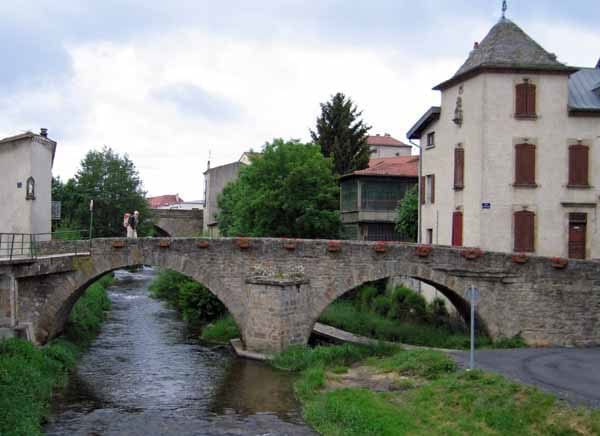
It was a wintry night and we slept huddled together, wearing every garment that we had, but even so our light sleeping bags were insufficient.
In the morning I finally visited the new shower block, which was in a sort of shipping container near the office. Without fully undressing I had a delightfully hot wash and dried myself on two large paper serviettes from last night’s dinner, thus avoiding the need to carry a wet towel.
When I got back to the tent there was an old fellow talking to Keith. He was a cyclist from Nîmes, on his way home now, and when we said that we would be at the Nîmes camping ground on the following Monday, he half-promised to come and pay us a visit (in fact we never saw him again). He had the smallest tent that we had ever seen, like a tiny inverted canoe.
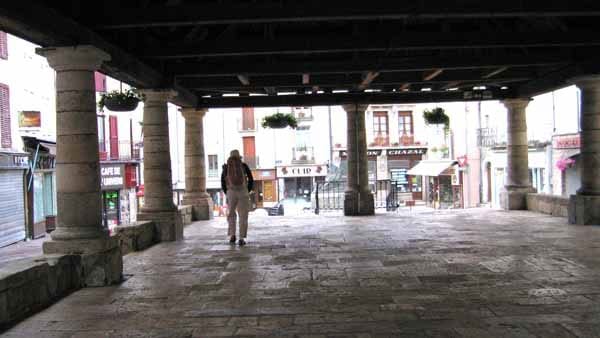
Back in town, we bought pastries at a shop in the Rue du Vieux Pont and carried them into the main street, which looked as dingy as last night but livelier. We still preferred it to Pradelles.
We settled down in a bar next to the market halle for our second breakfast, enjoying the warmth and bustle of the indoors.

Then it was time to face the day’s walk. Just on the other side of the Vieux Pont there was a post bristling with red and white signs.
It was the departure point for three GRs and a GRP, but it was easy to pick ours, the GR700, which turned right and climbed quickly out of the town.

We were soon on a dirt road running along through open farmland, with the ground dropping away on both sides. The gorge of the Allier on our left.
This alignment is typical of the “drailles” that were the first long-distance roads of the mountains, They usually followed the ridge line between two rivers, the easiest route for both mule-drivers and their flocks.
In former times this area was in the province of Gévaudan, notorious for the “Beast of Gévaudan”, a sort of giant wolf that terrorised the population in the eighteenth century, killing scores of people.
Half an hour’s walk brought us to the parting of the ways of the Régordane (GR700) and the Stevenson track (GR70).

Just after this our road entered a beech forest and became more and more broken-up. We followed it down a series of zig zags to a tumbling stream, a tributary of the Allier, where the bridge had been wrenched out of position by a flood.
No vehicle could have been this way for years, but walkers could get across the tangle of metal and concrete easily enough.
On the other side of the stream we left the road and struck upwards through the forest on a broad track littered with boulders.
We wondered whether these boulders were the original paving of the Régordane in its heyday, when teams of mules strained against their loads on the steep ascent.

The slope lessened and we arrived at the hamlet of les Fagoux (or Esfagoux in the local dialect).
The houses were made of unmortared stone and, although some had been restored, most were in the process of returning to the loose rocks from which they had been made. One of these roofless wrecks was for sale but we resisted the temptation.
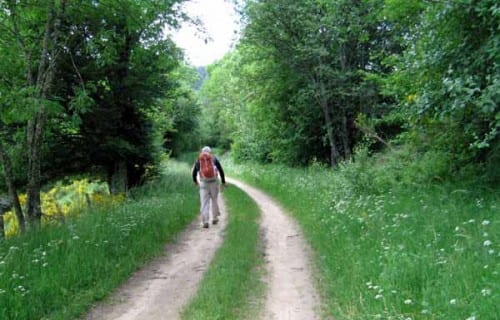
It was impossible to believe that only a kilometre down the steep bitumen road was the highway going along the river.
Going that way to Luc would have been a considerable short cut but we had no desire to do it. Instead we continued on the GR, which was now a smooth, tree-lined wheel track above fields that sloped down to a ravine.

With a bit of help from the GR marks, we negotiated the head of the ravine and eventually descended through brilliant fields of gorse to a road.
Here the GR turned right to make a picturesque deviation via a lake, but we had already done that on our previous walk in the area, so we went to the left and made quick work of the distance to the top of the escarpment.
By this point we had been joined by both GRs – the Régordane and the Stevenson. We could see the hills of the old province of Vivarais, far away beyond the Allier.

On its way down to Luc, the road switched to and fro across the hillside but the GR plunged like a stone, crossing the road several times. It was a loose, rocky path, probably the remnant of the paved mule track of the Régordane.
Somewhere here I realised that I had been enduring stones in my shoes all day, so I stopped and emptied out a few sharp fragments, but it was too late – one of them had cut the sole of my foot and it took a week to get better.
At last we got to the foot of the drop, where the ruins of the château stood on a grassy spur.
Robert Louis Stevenson had come this way and there was a huge panel carrying his description of the place, including the memorable meal that he had eaten at the local inn. We were definitely in RLS territory now.
Beside this panel was another, much smaller, inscribed with the words “Café Tabac”. It was midday and we felt a keen interest in coffee, so as we picked our way down to the streets of the village, we kept an eye out for another sign, but in vain.

It later transpired that we should have turned left along the first street that we came to, but the GR turned right, sloping down towards the church, and for lack of anyone to ask, we went that way. (Note that the map for this section shows the correct way to the café.)
A man emerged from a doorway and we sprang upon him to ask about a bar. Yes, there was one, but it was down on the highway, about half a kilometre back.

He was from Montpellier and was not pleased with the lack of warmth at his summer residence here.
Having set our hearts on coffee, we made the long descent to the highway and trudged back along it, past a steep flowering meadow, until we saw the red umbrellas of the bar.
Inside the sturdy old building we had the pleasure of drinking coffee in warm, comfortable surroundings, out of the chilly wind. I remarked to the barwoman that it had been hard to find the place and she replied that they had put up a sequence of four signs. We must have missed the second one, or else it had vanished.

Back along the highway, we soon found the GR coming down to join us from the church. On it were an extraordinary number of other walkers, although we had seen none earlier in the day. They straggled along in groups or singly, both in front and behind us. We felt like refugees from some disaster, all going the same way.
Just before Pranlac we left the highway and crossed the Allier on a hump-backed stone bridge. The river, so wide at Langogne, was now just a pebbly mountain stream.
We were now in the department of the Ardèche and could look over to the heights of Gévaudan, where we had been this morning.
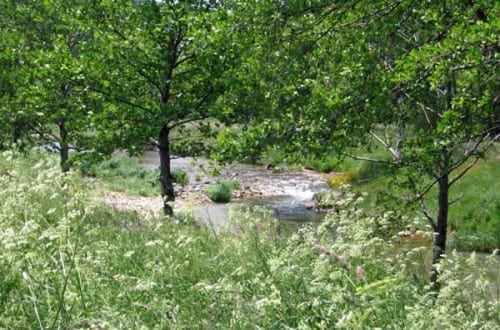
Past the decaying village of Laveyrune (forsaken when the new highway was put in), we arrived at the edge of Rogleton. Here the GR wandered upwards on a rough track, but we stayed on the road and got ahead of a large, slow-moving party of walkers.
For a short distance we were once again on the highway, which had just come over the river, but then we turned off, crossed the river on a low bridge and came to the railway line.
Although there were GR marks continuing over it, they were not for us – they were the GR7. Our route kept on beside the river, without crossing the railway bridge. It was pleasant to be off the bitumen at last, amongst fields of flowers.

At the small side stream of the Fraisse there was a footbridge, and immediately after that we went through a tunnel under the railway line.
The path switched back and scrambled up the hillside, then flattened out onto a path that was parallel to the railway line but above it. We could see it and the river far below us through the trees.
A couple of aged, frail-looking French walkers were just ahead of us on the track and they were so surprisingly speedy that we had trouble keeping up.
It was only a kilometre or so before we snaked down into the village of la Bastide-Puylaurent, crossed the railway tracks and arrived at the station, which stood opposite a huge block-like gîte.

This was a part of the village that we had not seen on our previous visit, but after crossing the river we came to the familiar main square, with its two hotels facing each other.
Having compared menus and room prices, we decided on Les Genets, where we had stayed last time. We tried the door but it was locked. Then it opened and a man, not our genial little host from before, admitted us to the bar.
The air was thick with cigarette smoke, not very promising, so we asked to have coffee while we decided on whether to take a room. This sent him into a bit of a rage – no room, no coffee, he declared belligerently. We walked out.

At the hotel across the road, we were served coffee by a much more obliging woman, but she had no rooms vacant, so after a little pause (we had forgotten to have lunch, but we were not hungry), we set off in search of the Étoile, another gîte that had been recommended to us.
It took us quite a while to find it, as it was back over the river, not far from the station.
It was a strange agglomeration of architectural styles, with a glassed-in sunroom and a low, flat-roofed wing tacked onto an older house, all painted white. Apparently it had been a hotel in the thirties.

We went in and were met by a tall, craggy, jovial fellow by the name of Philippe. Although we had not booked, he had room for us – dinner and breakfast were included in the price (€48 each), as in most gîtes.
Our host spoke English very well and had even been to Australia a couple of times. He invited us to use his computer to send an email, which was an unexpected bonus. We had a room to ourselves upstairs, but shared the bathroom.
Once clean and tidy, we drank tea in the sunroom while we waited for dinner. At 7:30 Philippe bellowed that dinner was served, and we all trooped into the dining room. A fire was burning in the grate behind the long table, as the evening was cool. There were about twenty of us.
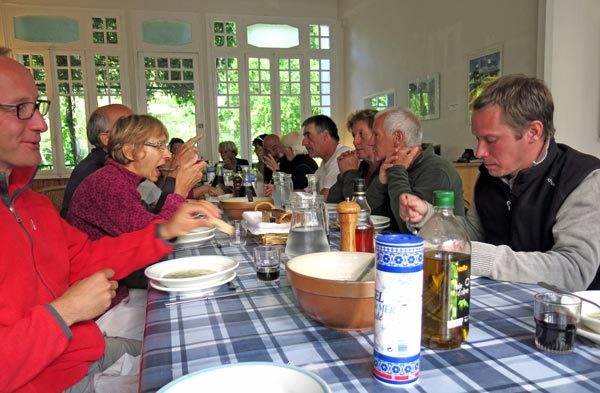
The meal began with a soup of root vegetables and wild herbs, cooked by our host, and accompanied by home-made bread.
Then great glass bowls appeared, full to the brim with grated carrot, with a fairy ring of hard-boiled eggs around the top. We did our best with this but could not eat it all.
The main course was spaghetti with a tasty sauce, then fruit tarts and a monumental cheese platter. We finished with verveine tea, but I stuck to wine when the tea appeared.

The company was mostly walkers doing the Robert Louis Stevenson walk, but some were on the Régordane and a few were just having a holiday.
I was able to have lively conversations with all the people around me – a Paris banker with distant relatives in Australia, a man from the Ardèche who knew all about the prehistoric caves there, and several others. Altogether it was an excellent evening.
Previous day: Bizac to Langogne